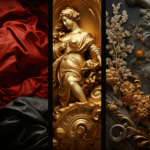Gold, with its radiant and lustrous allure, transcends the realm of the physical to become a symbol of divine presence and artistic excellence. Throughout history, gold has been intimately intertwined with art and religion, serving as a medium of spiritual expression, a source of inspiration, and a testament to human creativity. In this exploration of gold’s role in art and religion, we’ll journey through the ages to uncover the profound connection between this precious metal and the human spirit.

The Divine Canvas: Gold in Religious Art
Gold’s transcendent beauty and eternal shine have made it the ultimate canvas for religious expression across different faiths and cultures. It symbolizes purity, enlightenment, and the divine presence in artistic representations of the sacred.
Gold in Christian Art
In Christian art, gold leaf has been used for centuries to depict the divine radiance and holiness of religious figures, particularly in the form of religious icons and illuminated manuscripts. The use of gold in religious art dates back to the Byzantine Empire, where it adorned the mosaics and icons of churches like Hagia Sophia in Constantinople.
The “Halo,” a golden disk or ring encircling the head of saints and angels in Christian iconography, is a classic example of the symbolic use of gold to denote spiritual enlightenment. It serves as a visual representation of divine presence and holiness.
Gold in Islamic Art
Islamic art has a rich tradition of using intricate geometric patterns and calligraphy to create stunning works of art. Gold leaf and gold ink have been employed to embellish Quranic manuscripts, mosque interiors, and other sacred objects. The reflective quality of gold is seen as a metaphor for divine light and guidance in Islamic culture.
One of the most iconic examples of gold in Islamic art is the Dome of the Rock in Jerusalem. Its golden dome, adorned with intricate geometric patterns and inscriptions, is a masterpiece of Islamic architecture and a symbol of the connection between heaven and earth.
Gold in Hindu and Buddhist Art
In Hindu and Buddhist art, gold holds a significant place, representing spiritual purity and enlightenment. Golden statues and sculptures of deities are common in temples and shrines. The gilded roofs and ornaments of pagodas in Buddhism, such as the Shwedagon Pagoda in Myanmar, signify the spiritual ascent towards enlightenment.
The use of gold in these traditions reflects the belief in the divine radiance and the transformative power of spirituality. Gold is not merely an embellishment; it is a means of conveying the sacred.
Alchemy of the Soul: Gold Leaf and Illuminated Manuscripts
The use of gold leaf in illuminated manuscripts is a testament to the alchemical connection between art and spirituality. Illuminated manuscripts are handwritten texts adorned with intricate illustrations, decorative motifs, and ornamental initials. Gold leaf is often used to embellish these manuscripts, transforming them into radiant works of art.
The Lindisfarne Gospels
The Lindisfarne Gospels, created around 700 CE, is an exquisite example of illuminated manuscript art from the early Christian period. The pages of this manuscript are adorned with intricate designs in colored pigments and gold leaf. The gold accents not only enhance the visual appeal but also signify the divine nature of the text, which contains the four Gospels.
The Book of Kells
The Book of Kells, an illuminated manuscript created in the 9th century in Ireland, is renowned for its intricate detail and vibrant colors. Gold leaf is used to highlight the intricate interlace patterns and intricate illustrations throughout the manuscript. The lavish use of gold in the Book of Kells reflects the reverence for the Gospel text it contains.
Spiritual Alchemy
The use of gold leaf in illuminated manuscripts is akin to spiritual alchemy, where base materials are transformed into something sacred and divine. The painstaking craftsmanship involved in creating these manuscripts is a reflection of the devotion and reverence for the religious texts they contain.
Gold in Religious Objects and Rituals
Gold plays a central role in religious objects and rituals, serving as a conduit between the earthly and divine realms. Whether in the form of ceremonial vessels, religious symbols, or architectural embellishments, gold adds a layer of sacred significance to religious practices.
Chalices and Tabernacles
In Christianity, the chalice and tabernacle used during the Eucharist are often made of gold or adorned with gold leaf. These vessels hold the consecrated wine and hosts, symbolizing the blood and body of Christ. The use of gold in these objects reflects the sacred nature of the sacrament.
Religious Symbols
Gold is used to create religious symbols and artifacts in various faiths. For example, the Sikh religion uses a golden temple, the Harmandir Sahib, also known as the Golden Temple, as its central place of worship. The temple’s gilded exterior reflects the belief in the divine radiance and purity of the faith.
Architectural Embellishments
Gold is frequently used in the architectural embellishments of religious buildings, from the golden domes of Orthodox Christian churches to the golden spires of Buddhist pagodas. These architectural features serve as beacons of faith, guiding the devout and symbolizing the presence of the divine.
Gold as a Symbol of Transcendence
In art and religion, gold represents transcendence—the idea that there is something beyond the material world, something sacred and eternal. It serves as a bridge between the mundane and the divine, between the physical and the spiritual.
The Gilded Altarpiece
Altarpieces in Christian churches are often adorned with gold leaf. The altarpiece is the focal point of the church’s interior, and its gilded surfaces draw the eye upward, toward the heavens. The use of gold in the altarpiece signifies the presence of the divine and the aspiration toward spiritual connection.
The Buddha’s Golden Robes
In Buddhism, images of the Buddha are frequently depicted wearing golden robes. This symbolism extends beyond the opulence of appearance; it signifies the Buddha’s enlightenment and spiritual radiance. The golden robes represent the ultimate transformation of the human spirit.
Conclusion: The Eternal Connection
In conclusion, gold’s enduring connection with art and religion speaks to its timeless appeal and symbolic resonance. It has been the canvas for expressions of faith, the alchemical medium for illuminating sacred texts, and the sacred material for crafting religious objects and architectural wonders.
Gold’s use in art and religion transcends cultures, spanning continents and millennia. It reminds us of the profound and enduring human quest for the sacred and the divine, a quest that has found expression through the shimmering beauty of this precious metal.
As we delve further into the world of gold in this book, from its historical significance to its modern applications and economic implications, we must always remember that gold is more than just a metal; it is a symbol of the human spirit’s eternal yearning for transcendence.



